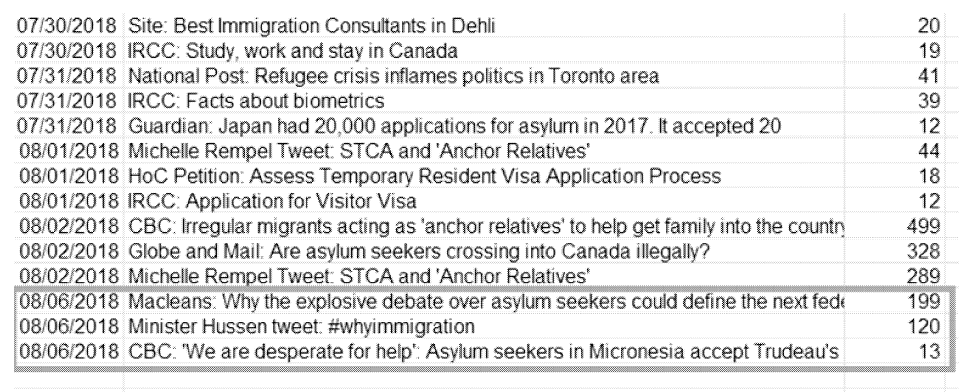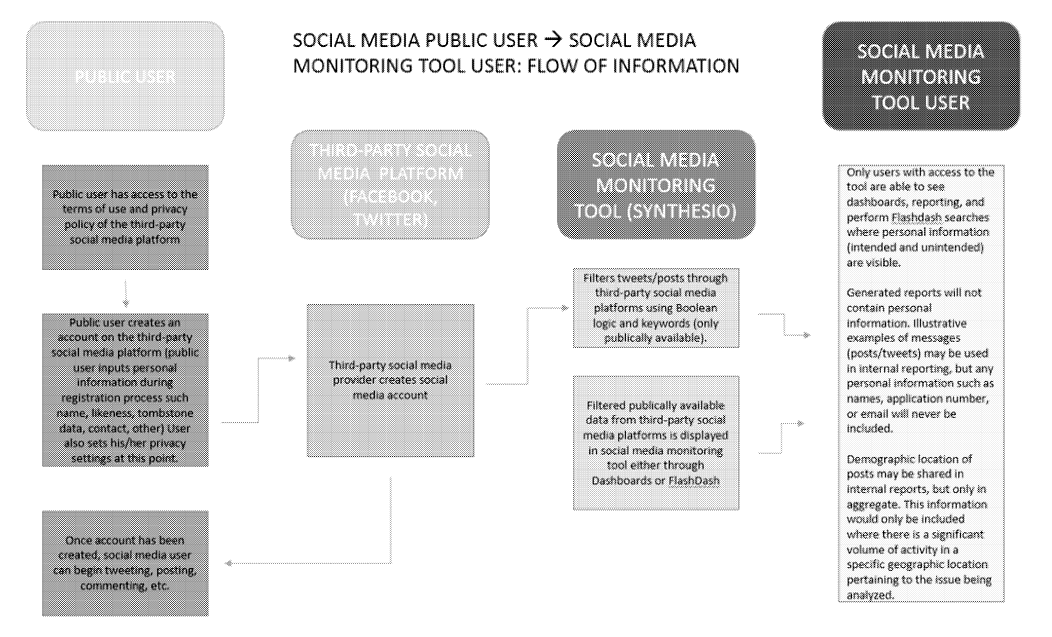What is social media listening?
According to IRCC – Listening refers to a general, more passive form of monitoring of social media results. When listening, analysts may not be acting upon results, or looking for any targeted topic or issue. The practice entails reviewing results sporadically during the day to monitor and review incoming social media results. Should something of interest appear, an analyst would be able to flag the incoming theme or topic of coverage. If there is nothing significant to report, it does not need to be flagged or reported.
An example of why IRCC does social listening – To understand Canadian opinion on social media in regards to ongoing irregular migration issues.
Examples of some of the tools IRCC uses and sites it monitors are as follows;

Background to the social media listening initiative at IRCC
IRCC’s Communications department has an interest in engaging in using a social media monitoring tool for searching/monitoring and analysis of social media traffic on issues relevant to the Department. As social media volumes are too large to navigate manually, the use of a tool allows IRCC to engage in more targeted and broad searches of social media content, and see the information presented in a more consolidated fashion. Such a tool would allow IRCC to better understand current opinion, sentiment and overall conversation on specific IRCC issues in order to create communications products that resonate with target audiences.
To conduct such searching, the tool pulls from publicly – available information provided by social media users: their public posts; their usernames; some data they have chosen to include in their social media profiles (e.g. name, city/ country of residence); and some information associated with their profiles (e.g. number of followers, number of tweets issued). The tool does not store this information; it merely retrieves and presents it through a user interface, and uses it for analysis purposes (e.g. presenting information in aggregate). The information that can be obtained by IRCC is unchanged by the use of the tool. The tool merely collects and presents the information in a more expedient way. The same information can be obtained by any member of the public through browsing or searching or social media sites.
That said, social media monitoring software allows its users to gather more information far more quickly and easily than would be possible through manual searching; it provides IRCC with the power to retrieve information which might otherwise have been left unseen. IRCC has the ability to uncover microscopic information from ordinary individuals – even if that information is technically public.
Does IRCC engage with social media influencers?
IRCC has a protocol in place for the identification and engagement of influencers. The Department defines influencers (within a social media context) as people who hold clout with a particular audience: someone with a significant amount of followers, who posts regularly, and engages with their audience. An influencer may be influential in one specific area (e.g. an academic or journalist in a certain field; a celebrity within a certain genre of music), or may be considered more generally influential. Depending on the subject matter, they may be intentionally positioning themselves as a voice of authority, with or without relevant credentials.
Influencers do not need to be celebrities, or even stakeholders, in the traditional sense. For example, “CD” (initialized for anonymity) is a social media influencer for IRCC’s International Experience Canada program. She is a parent whose children previously went through IEC, and she now guides other youth through the process by responding to questions over social media. CD is at times an unofficial liaison, taking in questions from youth who are using private IEC groups, and getting responses from the official IEC channel to share back. While CD has a limited following herself, she is considered influential to a specific audience.
IRCC uncovered an instance where an individual was sharing misinformation about seeking asylum status in Canada. This individual had a relatively large following (over 5,000 followers) and was presenting herself as a voice of authority on the issue. The information she was providing was misleading and potentially introduced safety and legal risks to those who might choose to follow her advice. IRCC responded by posting messaging on the individual’s pages to make her audience aware that misinformation is prevailing online, and that the Government of Canada website should be consulted as an official source of information.
By contrast, IRCC would not engage what is considers “ordinary individuals” in the same way that it would engage influencers. An ordinary individual is considered as someone who:
- Does not have a large following;
- Does not appear to have any clout with a broad audience (i.e. a larger audience than the individual’s personal networks); and/or
- Does not appear to be speaking as a voice of authority on a given subject.
These factors need to be considered holistically when analyzing an individual’s activity to assess potential influencer status.
- For example, if an individual was regularly sharing misinformation about seeking asylum status in Canada, but their content appeared to gain no traction within the social media sphere, the person would not be considered an influencer. However, this might change if they issued one tweet which gained significant traction and was seen by hundreds of thousands of people.
- To use the above example, the actress was considered an influencer because of her popularity with Greek/Canadian audiences; however, this does not mean that any individual with many followers in key geographies should be considered influential and engaged to reach a target audience. The actress has clout with a broader audience, rather than merely her personal networks; she would also have a decreased expectation of privacy with regards to her social media activity, due to her celebrity status.
Social media monitoring software allows IRCC to more easily identify potential influencers, particularly on topics that do not see widespread discussion. However, regardless of who the monitoring tool may identify as an influencer, IRCC assesses the individual’s activity using the factors above, and determines any subsequent action based on this assessment.

